Post-excavation report, 2006
Season Reports
Post-excavation report, 2006
Original drawings by Gregory Gilbert, Joanne Rowland, Janine Wilson and Lauren Woodard. Ink drawings by Lauren Woodard.
The kiln in the earlier layers of Excavation 1 (see Report for 2003) was one of the best sealed contexts from the excavation. This means that the material found in this kiln was of the same date and had been buried at the same time. The end of the use of the kiln seems to have coincided with the burial of the material, perhaps in this case by the collapse of the roof. Therefore the date of the material and the event would be the same. If one or the other can be dated, then the context (the exact location and feature) from which the material came can also be dated.
The dating of the material is carried out by finding comparable objects from other dated sites. In some cases the dates may give a range perhaps covering a few years, a king’s reign, a whole dynasty or even a time period. By obtaining date ranges for several different objects, then the common date range will be the most likely for our objects.
The Lower Layers of the Kiln [1059]
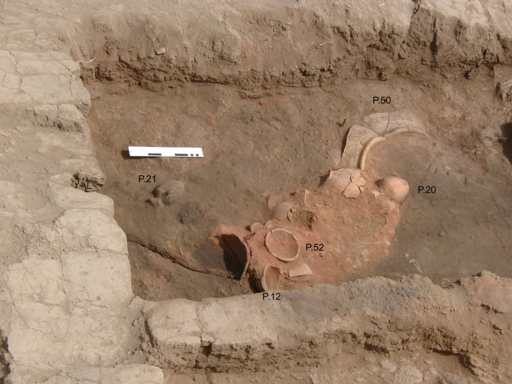
Kiln [1059] with pottery.
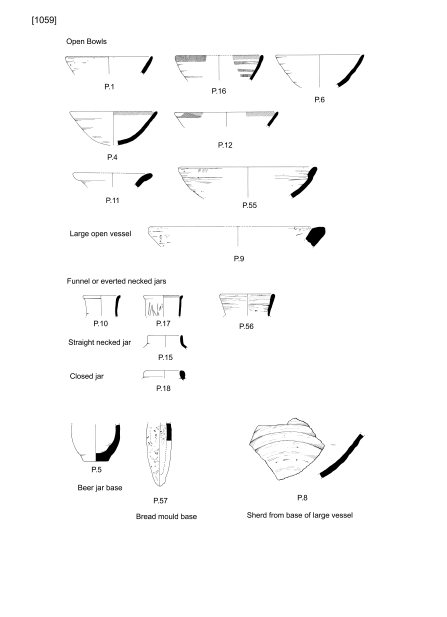
Above and below : Pottery sheets for [1059].
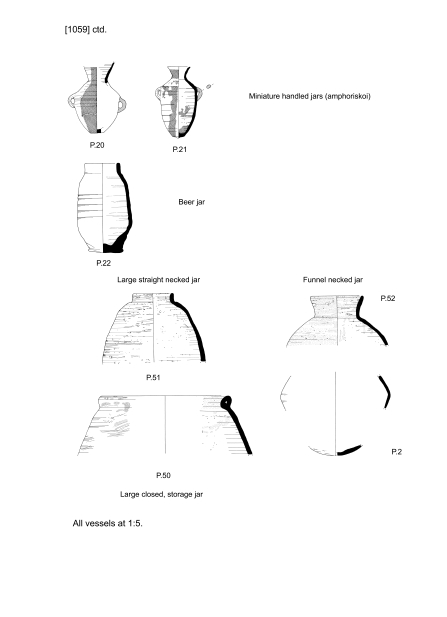
P.20 and P.21 are two almost complete small jars with handles, often called an amphoriskos (small amphora).
They have different shapes with P.20 having a wider body with the widest part of the vessel higher at the shoulder of the jar. It has a wide, flared neck and the base was almost flat. It was made of Nile silt fabric with the additional of fine chaff and mica. The outside of the vessel was covered in a cream coloured paint or slip which had been burnt orange.
P.21 on the other hand has a more slender body coming to a point at the base. It has a very narrow neck and flared opening. It is made of Nile silt fabric also, with the addition of fine chaff and mica. The vessel had fired to a brown colour.
P.12 is the base of a beer jar. They are very common at Kom Rebwa and vary between jars with holes through the base which were made before the vessel was fired, and jar which have no holes. The exact reason for the holes in the bottom of the jars is not yet firmly established.
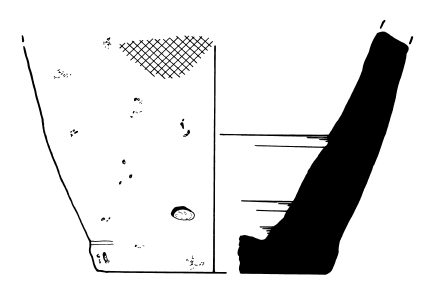
Detail of a beer jar base from another context with a hole made before firing.
P.50 is the rim of large closed jar. It is made of a fabric which may be a mixture of Nile silt and a marl clay, resulting in a very versatile fabric. It could be made into large storage jars and amphorae but with slightly thinner walls than would be required for a large Nile silt jar. This meant that it would be a little lighter but just as strong and less porous than a Nile silt vessel. The outside of the vessel and interior of the rim was painted with a cream slip. The estimated diameter of the rim was around 30 cm, so it may have been up to a metre in height and perhaps had a bag-like shape.
P.52 is part of the rim and neck of a flared neck jar and shoulder. The fabric of this vessel is distinctive as it is a Nile silt with the addition of mica (Sais FN4). If the fabric is broken the mica can be seen as small shiny inclusions in the clay. The pottery it is also usually quite thin in comparison to Nile silt vessels with onyl the addition of chaff or limestone. The vessel would probably have had a bulbous body with a wide rounded base, as perhaps indicated by other sherds found in the same context. It has been suggested that the inclusion of a high percentage of mica increased the heat distribution of the fabric, making it useful for cooking pots where the heat needed to be distributed quickly and evenly. The outside of the vessel has a creamy-red slip, which is usually wiped or smeared over the surface creating a ‘Tiger stripe’ effect.
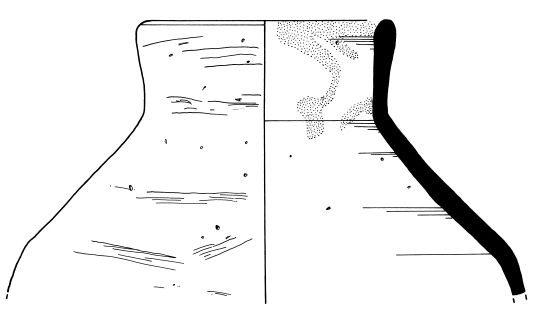
Flared jar neck detail.
The rim diameter is around 12 cm and the flared type of neck may suggest that liquids were poured from vessels such as this. The flared neck would ensure that the substance could be poured out easily.
The fabric may be compared to that identified at Qantir as Fabric type IIIA and is increasingly used in Dynasties 20 and 21, including as the fabric for globular jars with flared necks.
Upper layers of the kiln [1082]
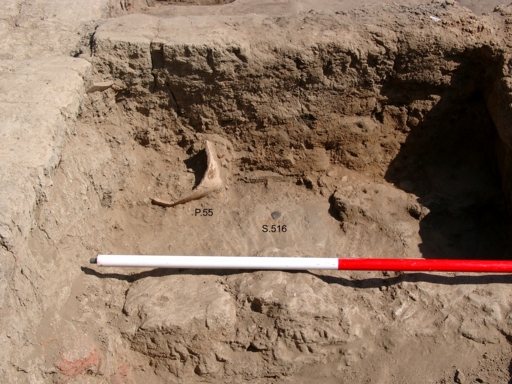
Context [1082], a compartment of the upper layers of the kiln. The two objects visible are the funnel P.55 and the gaming piece S.516.
This part of the kiln seems to have been constructed after the earlier context [1059] had fallen out of use. The pottery here was placed into the small compartment above the original kiln level which may have been used as some kind of cupboard.

P.55 The funnel.
The fragments of the vessel were well preserved so that a complete profile from the rime to the base could be drawn. The vessel looks like an ordinary bowl, but has a hole in the base. It is assumed that the bowl was placed over the wide neck of a large jar or sack and liquids or small solids (such as grain) were poured into the larger container. The funnel would ensure that there was no loss of the contents. Every grain of barley or drop of beer would have been jealously husbanded.
The fabric of this vessel seems to be the marl clay Nile silt mix described above, which had a layer of thick cream slip applied to the outside.
The diameter of the funnel is 24.5 cm.
Funnels have also been found at Qantir dating to the Ramesside period in fabric IIIA (2150).
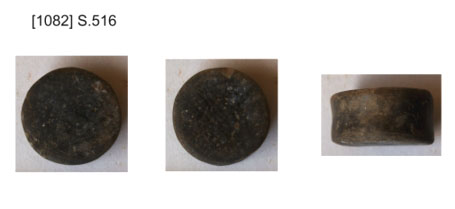
Small find S.516, a gaming piece.
This small object, with a maximum diameter of 2.5 cm and thickness of 1.2 cm is perhaps a gaming pieces. It is made of Nile silt pottery with added sand, and then coated in a black glossy paint. The object has the shape of a small bobbin with central indented band. Many such pieces have been found in the Kom Rebwa excavation and the objects range in size from around 2 cm in diameter to 3 cm in diameter. It is likely that they are gaming pieces, because of their size and number, but their pulley-like form may suggest that they could also have been used as bobbins for thread or as spindle whorls for fine thread. The presence of this object in the same context as the funnel suggests that this is not a sealed context like [1059] but may be more disturbed, with material collected here from mud brick debris or from fill.
Other Pottery from Kom Rebwa
Over one thousand diagnostic fragments of pottery have been drawn from Kom Rebwa Excavation 1. A basic fabric type has been produced by Drs Sylvie Marchand and Catherine Defernez of the Institut Français d’Archéologie Oriental in Cairo (see Sais Report 2003). This method of classifying pottery is very useful fro determining the mode of manufacture of the pottery fabrics and whether fabric materials have been brought in from outside to add to the Nile silt available locally. Sais is not near a recognised local source of marl clay, so that any evidence for marl clays will suggest that it or the pottery has been brought into the area, most likely from the south.
The fabric type can also relate to the type of vessel or object. For example the simple bowls were most often made of Nile silt with the addition of varying amounts of fine chaff, sand and fine limestone. Bowls constitute the most common type of vessel from Kom Rebwa and were used for many purposes such as drinking, eating, basic and widely used containers, lids and bases forming closed units when put together or singly as lids for other types of vessel, lamps and decanting vessels (that is for taking substances from large storage jars and pouring them into smaller vessels). They could be easily made on a wheel and replaced quickly when broken. In the New Kingdom bowls were often decorated by turning them upside down and dipping them into red paint, so that the inner and outside rim has a red colour.
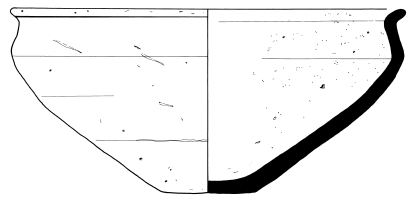
Carinated bowl.
This type of bowl is straight from the rim to the shoulder and then the vessel takes a sharp turn inside toward the body of the vessel, before flattening to form the base. This shape takes its name from the Latin word for the keel of ship and is known as a carinated bowl. It was a popular shape for household containers and domestic vessels. The type here was found in the uppermost levels of Kom Rebwa Excavation 1 and probably dates to the Third Intermediate Period.
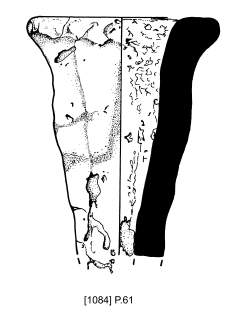 Bread mould rim from context [1084]. | 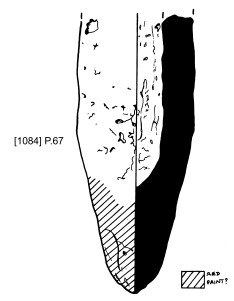 Bread mould base from context [1084]. |
The context [1084] produced a large number of sherds from bread moulds. These were made from Nile silt with the addition of much fine chaff and sometimes some larger straw pieces, perhaps to make the clay more malleable. These moulds were made by hand and probably formed into their distinctive elongated shape by applying the clay over a ready-formed mould. The moulds were usually painted with a cream whitewash on the outside. Once fired the bread dough would have been pushed down into the mould. The moulds would have been stacked in a fire and the bread baked. The resulting bread would have been more like bread sticks than bread loaves. Once they had cooled the bread was tipped out of the mould so that it could be reused.
Such moulds are very common throughout the Ramesside and Third Intermediate Period layers at Kom Rebwa and may have been used to produce bread which was used for a particular purpose. This might have been for use in cult,t hat is small portions of bread which could be offered to the gods, or as a particular kind of delicacy of flavoured bread for elite households.
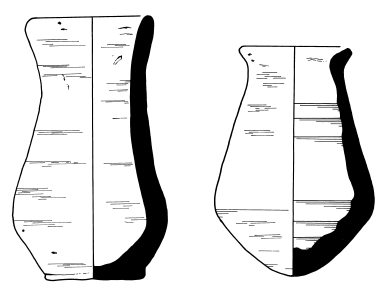
Small containers, perhaps for perfume or resin.
These two vessels were found in the upper layers which were very disturbed. They have probably survived because they are small and so less likely to shatter or to be broken. They are 15 cm and 12 cm tall respectively and the vessel on the left was found to have traces of a black substance on the inside, no doubt the original contents of the jar. It still had a slightly sweet smell and so may have been a perfume or resin. Both vessels were made of Nile silt with some limestone inclusions, so in themselves they were not valuable vessels. they may have been used to decant or measure out quantities of oil or perfume from larger vessels.
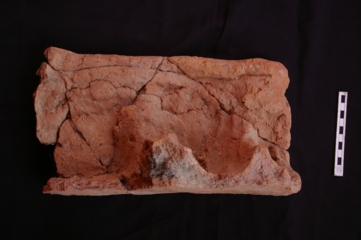 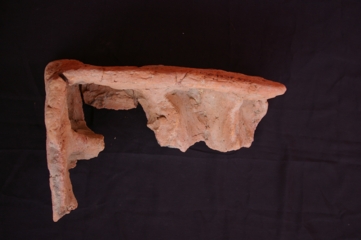 | Left above and below : a soul house? |
These are two images of the same object which was found as part of the mud-brick and debris used to build the wall around the kiln [1059]. The object is made from pottery, that is Nile silt with the addition of some fine limestone, chaff, straw and some sand. It was hand made and seems to have been well formed. The object seems to be some kind of open box shape, with a base flat underneath but with some hand-moulded areas on the upper surface. The four sides incline towards the inside, creating a sloping effect for the profile of the walls. There are indications that the interior of the object had small partitions or perhaps freehanded moulded shapes and forms. Although the object is not complete, it may be possible to identify it as a ‘soul-house’ or even a temple model.
Soul-houses are known from the Middle Kingdom from cemetery sites such s Deir el Rifeh, where they represent models of houses which were placed in tombs. They may have been intended as residences for the ka-spirit of the dead. Another type of tray placed in tombs was a shallower dish like tray with moulded offerings consisting of meat, bread and vegetables. When water or another liquid was poured over these offerings they were activated and could provide sustenance of the dead/
The Sais example has no direct context as it was reused for building purposes and it has not real comparanda as it is is from Lower Egypt (no other soul houses or miniature structures are known from definite archaeological contexts in the north). The sloping walls and the internal partitions suggest that it is meant to be a miniature building of some kind and may represent a granary or even a temple structure.
If any readers of this website have any ideas about the identity of this object we would be most interested to hear from you.
Further Reading on Pottery
D. Aston, Die Keramik des Grabungsplatzes Q I Teil I Corpus of Fabrics, Wares and Shapes, Mainz, 1998.
J. D. Bourriau, et al., The Memphite Tomb of Horemheb. Commander-in-Chief of Tutankhamun III The New Kingdom Pottery, London 2005.
J. D. Bourriau, L.M.V. Smith and P.T. Nicholson, New Kingdom Pottery Fabrics. Nile Clay and Mixed/marl Clay Fabrics from Memphis and Amarna, London 2000.
Forthcoming publications from the Sais Project
Kom Rebwa (Sa el-Hagar): Final Excavation Report : The Ramesside Period
The Prehistoric Period at Sais (Sa el-Hagar): Final Excavation Report
The Regional Survey of the Western Delta (N. Beheira and Kafr esh Sheikh Provinces)
Kom Rebwa (Sa el-Hagar): Final Excavation Report : The Third Intermediate Period
Saite Period Excavations at Sais (Sa el-Hagar) : Final Report
